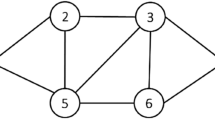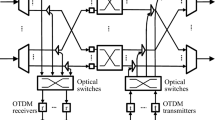Abstract
Light trail networks have been proposed as an extension of lightpath networks in order to enable sub-wavelength bandwidth allocation in WDM networks. The networks need a medium access control (MAC) method to avoid collisions of data transmissions. We have proposed a MAC method which adopts a token-passing mechanism. The method splits one trail into two trails: one upstream trail and one downstream trail and permits independent data transmissions on the trails. However, the method leaves bandwidths of links upstream from the token-holding node idle because the method only splits the original trail into two trails and leaves the upstream trail unsplit. In this paper, we propose a novel token-passing MAC method for further improving trail throughputs. Our proposed method recursively splits the upstream trail, and consequently the original trail can be split into more than two trails. In the proposed method, an appropriate setting of upstream/downstream token-holding times of all nodes is a key factor to successfully accommodate an input traffic. Therefore, we tackle a problem (called a token-holding time decision problem) where we optimize token-holding times of all nodes so that input traffic is successfully accommodated. We formulate the problem as a linear programming model. Numerical examples on maximum effective throughput show that the proposed method is more superior as the ratio of short-hop traffic is higher in input traffic patterns.























Similar content being viewed by others
Notes
LT-FA MAC and ART MAC permit nodes on a trail to release the token early before their token- holding times expire, while the NS method prohibits the early release of the token.
Access delay of a node is kept constant because DT-holding times of any nodes are kept constant in NS, SS, and MS methods as shown in Sect. 2.2.
References
Chlamtac, I., Ganz, A., Karmi, G.: Lightpath communications: an approach to high bandwidth optical WAN’s. IEEE Trans. Commun. 40, 1171–1182 (1992)
Gumaste, A., Chlamtac, I.: Light-trails: a novel conceptual framework for conducting optical communications. In: HPSR’2003, pp. 251–256 (2003)
Chlamtac, I., Gumaste, A.: Light-trails: a solution for IP-centric communication. In: QoS-IP’2003, pp. 634–644 (2003)
Gumaste, A., Chlamtac, I.: Light-trails: an optical solution for IP transport. OSA J. Opt. Netw. 3, 261–281 (2004)
VanderHorn, N. A., Balasubramanian, S., Mine, M., Somani, A. K.: Light-trail testbed for IP-centric applications. IEEE Commun. Mag. 43, s5–s10 (2005)
VanderHorn, N. A.: Fiber optical networks: fairness, access controls and prototyping. Ph.D. thesis, Iowa State University (2007)
Tran, N. C., Kim, E., Kim, K., Park, J.: Two novel configurations and an adaptive round-time MAC for light-trail IP-centric applications. In: OECC/IOOC’2007 (2007)
Fukushima, Y., Tanaka, K., Chen, W., Yokohira, T.: Dynamic splitting of light trails for increasing throughput in light trail networks. In: ITC-CSCC’2009, C-11-0262 (2009)
Chen, W., Fukushima, Y., Yokohira, T.: Optimization of Token holding times in split trail networks. In: GLOBECOM’2011 (2011)
Chen, W., Fukushima, Y., Yokohira, T.: An architecture and a MAC protocol for throughput improvement in light trail networks. IEICE Trans. Commun. E95-B, 2330–2343 (2012)
Gumaste, A., Jukan, A. Lodha, A., Chen, X., Ghani, N.: A novel node architecture for light-trail provisioning in mesh WDM metro networks. In: OFC/NFOEC’2008, pp. 1–3 (2008)
Fang, J., He, W., Somani, A.K.: Optimal light trail design in WDM optical networks. In: ICC’2004, pp. 1699–1703 (2004)
Grotschel, M., Lovasz, L., Schrijver, A.: The ellipsoid method and its consequences in combinatorial optimization. Combinatorica. 1, 169–197 (1981)
Karmarkar. N.: A new polynomial-time algorithm for linear programming. In: STOC’84, pp. 302–311 (1984)
Ibm, ILOG CPLEX Optimizer: http://www-01.ibm.com/software/commerce/optimization/cplex-optimizer. Accessed 16 July 2014
Author information
Authors and Affiliations
Corresponding author
Additional information
This work was done when the author was in Okayama university.
Rights and permissions
About this article
Cite this article
Fukushima, Y., Chen, W. & Yokohira, T. A trail multi-splitting method for throughput improvement in light trail networks. Photon Netw Commun 30, 178–189 (2015). https://doi.org/10.1007/s11107-015-0509-z
Received:
Accepted:
Published:
Issue Date:
DOI: https://doi.org/10.1007/s11107-015-0509-z




